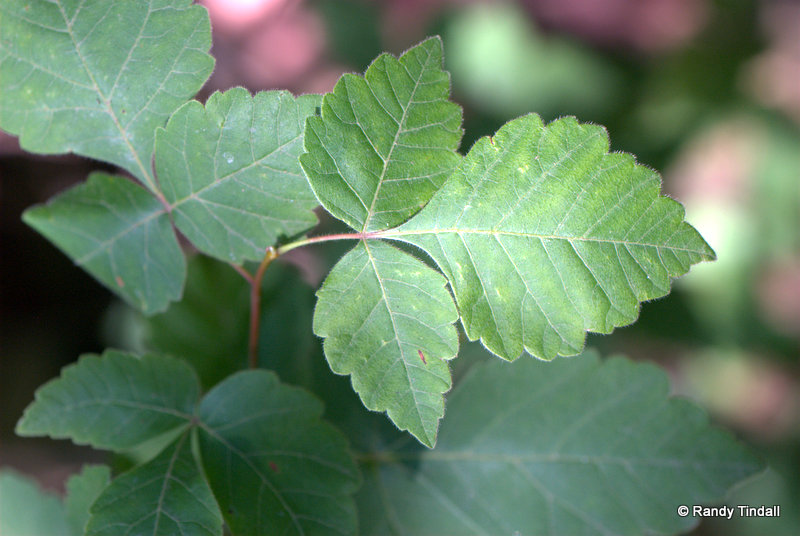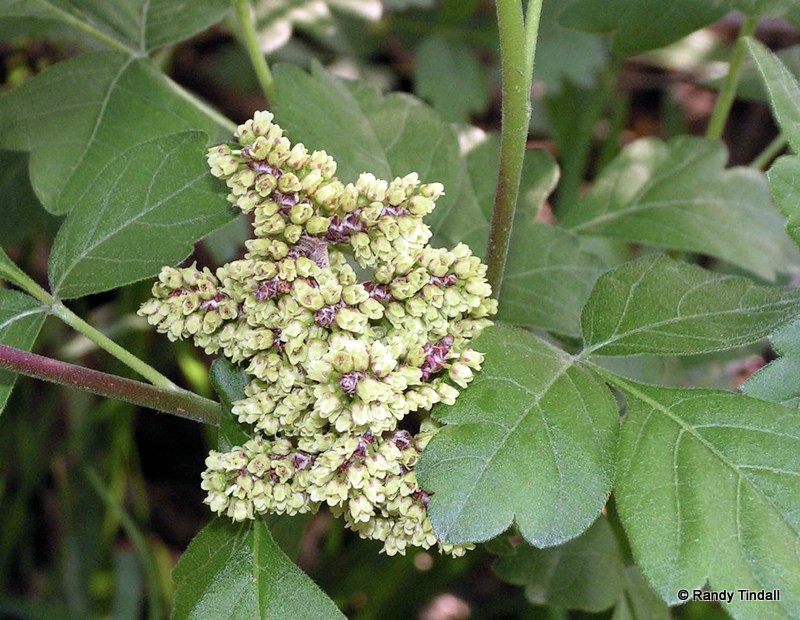Mention “sumac” in some circles and the word “poison” often comes up. Try it sometime. It doesn’t help when you’re discussing Aromatic Sumac and someone points out the distinctive trifoliate leaves and shouts, “See! Poison Ivy! Same thing!”
Well, no, it’s not. But the power of suggestion can be overwhelming at times. Consider this account, from fellow blogger Paul Lamble:
“I was once walking the woods with a man and he saw a paper cup down in the base of an aromatic sumac bush. He is a neat and conscientious man, and he couldn’t abide the litter. ‘Why would someone throw trash into a clump of poison ivy?’ he asked. I didn’t want to correct him at the time since his mild indignation seemed to be more important.
He very carefully snaked his arm down amidst the branches of the sumac and snatched the cup. Then he carefully extracted his arm, saying ‘I can catch poison ivy just by looking at the plant.’
Later that evening, as we were sitting in our tent, he showed me his arm, and sure enuf, it was red and inflamed. He reported that it itched terribly. I know that many people mis-identify aromatic sumac for poison ivy, but this was the first time I’d ever seen someone contract poison ivy from a sumac. I didn’t have the heart to correct him.”
Aromatic Sumac (or “Automatic Sumac”, as it’s known in our backyard—it’s fun having a spouse with an accent) is related to Poison Ivy (Toxicodendron radicans), but waaay more benign. Both of these plants, along with the real Poison Sumac (Rhus vernix L. are in the Anacardiaceae family, which also contains cashews and, sometimes, pistachios, depending on the authority. But since Poison Sumac has never been documented in Missouri, we won’t worry about it here.
So, if Aromatic, or Fragrant, Sumac isn’t these things, what is it? For us, it’s a medium-sized shrub in our backyard, which likes to extend exploring arms onto our deck. Smush the aforementioned trifoliate leaves and it emits a pleasant, somewhat citrusy smell, and those leaves follow the sumac tradition of turning pretty shades of red, orange and yellow in the fall. Its yellowish flowers show up before the leaves do in the spring and yield small clumps of reddish berries that can hang on all winter, if the birds don’t get them, and can persist into the spring (although ours didn’t).
This native is known to be tolerant of different soil types and habitats, shade conditions, and soil moisture differences. It seems not to be bothered much by pests or diseases and is drought resistant, and except for trimming back those curious branches that like to explore decks, pretty much requires no maintenance on our part.
What do we get out of it? As one of our earliest bloomers, it’s an early spring snack for native pollinators, such as bees, and for some birds. It’s very pretty in the fall, attracts some butterflies and also acts as winter food for the birds. It makes a nice border along fences (or our deck) and is deer resistant (although our blogger friend above says it can be heavily browsed by deer in his neck of the woods). One source suggests using a commercial variety of this shrub, called Gro-Low, as a way of discouraging deer from munching on parts of your garden you don’t want munched.
So, with those nice-smelling leaves and flowers, can we consume it? It’s been tried, but never became fashionable, due to the high tannin content of the leaves. I mean, do YOU want to drink something that’s been used to tan leather? Also, as a cautionary note, it has been claimed that, as a relative of Poison Ivy, there may be trace amounts of the nasty ingredient that make people blister and itch. Super-sensitive individuals might have a bad reaction, so consider yourself cautioned. Maybe our picker of litter above wasn’t so crazy after all?
It’s been smoked by Native Americans in a mixture of tobacco and other native plants (no reports of similar uses by college students, and I’m not telling), and medicinally Dr. J. F. McClanahan, of Boonville, Mo., described its use in the late 1800’s as “a remedy highly useful in the treatment of diabetes, enuresis, hcematuria, uterine hemorrhages, menorrhagia and other excessive discharges, accompanied by a relaxed condition of the uterus, diarrhoea and other atonic diseases of the bowels.”
For you chicken aficianados, it’s been claimed that a bunch of aromatic sumac in chickens’ drinking water will stop roup or chicken cholera lickety-split, and that, ladies and gentleman, is the first time I’d ever heard of roup or chicken cholera, but at least I know how to cure it now.
Finally, it can be used to make dyes, ranging from yellow to dark-blue and black. Looks a little complicated. Let us know if it works for you.
As for us, we don’t eat it, tan leather with it, cure our bowels with it, or use it to color things. We just let it grow around our deck and enjoy its flowers in the spring and foliage in the fall, and it doesn’t really ask anything in return. But, since Columbia now allows backyard chicken-raising, if we ever decide to go the poultry route, and if we see some roup coming, we’re all set.



What I’ve noticed is that the deer will browse the flowers of the sumac, but you’re right, they do then to leave the leaves alone.
I have a second year growing Rhus Aromatica, which I believe is called also
Aromatica Sumac.
Has grown fast in front of house facing South.
Deer are doing more than browsing, just plain eating the leaves off.
It is now 4 feet tall and I have it in a cage as I want to save and transplant.
I have a sunny back yard with Texas East and West exposure.
There is a some portion that I have shade.
My question is — does it do well, okay in direct East/West Sun or do
I think about transplanting where I do have shade from Oaks coming
over the fence?
I just love it and so happy I have a great nursery that gives us this
service to try something new and exciting.
Best regard,
Cherie Bidell
Hi Cherie,
Thanks for your comment! Nadia is the botanist around here and she tells me that Aromatic sumac can tolerate full sun to partial shade. We have it in our front yard in a western exposure, where it gets partial sun in the afternoons (shaded by a sweetgum tree for part of the time). We also have it in our backyard with an eastern exposure where it now gets full sun for a good part of the day, but used to be shaded by a maple that died recently and was just removed. The moral of the story is that this plant seems to tolerate partial shade to full sun. My own opinion is that it likes a little shade. It tolerates poor soils, too, so this is a plant that can deal with different conditions. Keep the deer off it and it should do fine.
Thanks for reading!
Thanks for this post. I have had multiple people that this is poison ivy (including Google Lens) but none of the other photos that came up resembled the plant. Finally I searched “missouri sumac” on a hunch and found your post. We are new to Missouri and have a large bush of the stuff. It’s VERY aromatic when I trim it, but not in a bad way. I’m glad to know that it’s not likely to cause my kids any trouble. Thanks again.
Thank YOU for reading! Happy to be of help.